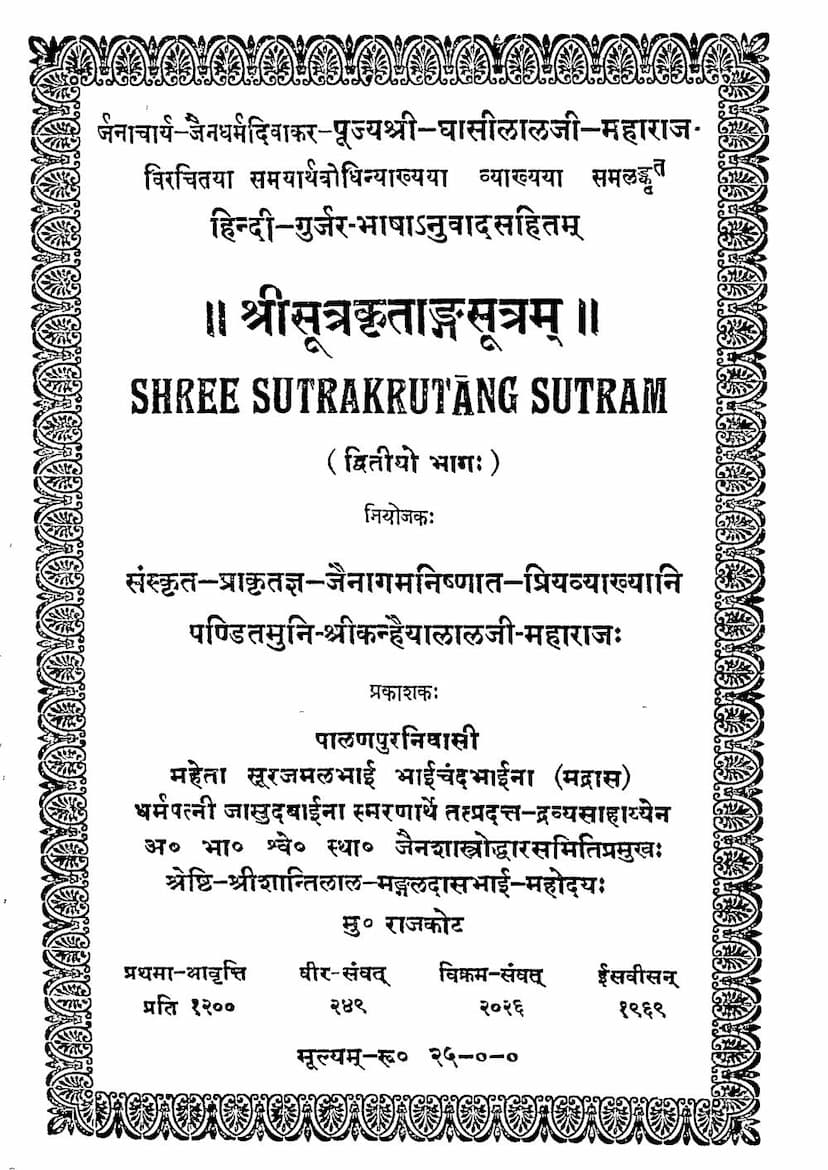Sutrakrutanga Sutram Part 02
Added to library: September 2, 2025

Summary
Here is a comprehensive summary of the provided Jain text, "Sutrakrutanga Sutram Part 02" by Ghasilal Maharaj:
Book Title: Sutrakrutanga Sutram Part 02 Author: Ghasilal Maharaj Publisher: A B Shwetambar Sthanakwasi Jain Shastroddhar Samiti Catalog Link: https://jainqq.org/explore/009304/1
This text is the second part of the Sutrakrutanga Sutra, a foundational text in Jainism. The book includes the original Sanskrit/Prakrit text, a Hindi translation, and a Gujarati translation, along with a commentary named "Samayarth Bodhini" by Ghasilal Maharaj. The compilation was organized by Pandit Muni Shri Kanhaiyalalji Maharaj and published by the Akhil Bharat Shwetambar Sthanakwasi Jain Shastroddhara Samiti.
Overall Content and Purpose:
The Sutrakrutanga Sutra is known for its detailed analysis of different philosophical viewpoints (swasamaya and parsamaya) and its exposition on the nature of ascetics, their practices, and the challenges they face. This second part continues this exploration, focusing on the third, fourth, fifth, and sixth chapters (adhyayan), as well as the commencement of the seventh and eighth chapters. A significant portion of the text delves into the topic of upargas (afflictions or hardships faced by ascetics) and parishaha (endurance tests), offering guidance on how to overcome them.
Key Themes and Content Summary (Chapter-wise breakdown based on the provided text):
The provided text gives a detailed index and begins the commentary on the Third Adhyayan, setting the stage for the rest of the volume. Based on the index and the initial commentary, the likely themes of the chapters covered in this part include:
-
Third Adhyayan (Trito Adhyayan):
- Focus: Primarily on parishaha (endurance tests) and upargas (afflictions).
- Content: The commentary begins by referencing the previous chapter's discussion of self and other doctrines. The third adhyayan aims to teach how a monk, possessing right knowledge and engaged in samyama (restraint), should face both favorable and unfavorable upargas with equanimity.
- Key Topics (from the index):
- The virtue of enduring parishaha and upargas.
- The rigor and difficulty of samyama.
- Specific parishahas like begging (bhiksha), injury (vadh), insect bites (danshmashkadi), hair-pulling (keshalonchan), facing non-Jain ascetics (paratirthikon ka pidit karne), and the conclusion of the adhyayan.
- The second uddesa (section) of the third adhyayan discusses favorable upargas.
- The third uddesa deals with the subversion of samyama due to upargas and refuting the arguments of other sects (anyathikon dwara kahi jane wale aksep vachanon ka nirupan).
- The fourth uddesa offers advice to ascetics who have faltered from the path (marg se skhalit hue sadhu ko updes).
-
Fourth Adhyayan (Chauth Adhyayan):
- Focus: Likely continues the discussion on obstacles to samyama, possibly including those related to sensory pleasures or specific types of misconduct.
- Key Topics (from the index):
- The parishaha of woman (stri parishaha).
- The karmic bondage of a faltered ascetic (skhalit sadhu ke karmbandh ka nirupan).
-
Fifth Adhyayan (Pancham Adhyayan):
- Focus: Begins with discussions on dana (giving/charity) and then delves into the torments of hell (narakiya vedana).
- Key Topics (from the index):
- Dana (giving/charity).
- Hellish torments (narakiya vedana ka nirupan).
- Commentary Excerpt: The initial part of the commentary for the fifth adhyayan indicates a shift to describing the suffering in hell, addressing the question of how beings fall into hell and the nature of their torment. This includes vivid descriptions of the punishments and the causes leading to them.
-
Sixth Adhyayan (Chhatta Adhyayan):
- Focus: Praising the virtues of Lord Mahavir.
- Key Topics (from the index):
- Description of the virtues of Lord Mahavir (Mahavir Bhagwan ke gunon ka varnan).
-
Seventh Adhyayan (Saatvan Adhyayan):
- Focus: Discussing the faults of the impure or those who have deviated from the right path (kushilwalo ke doshon ka kathan).
-
Eighth Adhyayan (Aathvan Adhyayan):
- Focus: Defining the nature of strength or vigor (virya ke swaroop ka nirupan).
Key Philosophical and Ethical Teachings:
- Endurance and Equanimity: The text emphasizes the importance of samyama (restraint) and the ability to endure various hardships (parishaha) and afflictions (upargas) without faltering. This is crucial for spiritual progress.
- Critique of Other Sects: The Sutrakrutanga is known for its critical examination of other religious and philosophical views prevalent in ancient India. The third adhyayan, as indicated by the index, likely discusses and refutes the doctrines of non-Jain ascetics.
- The Nature of Suffering: The fifth adhyayan's focus on hellish punishments provides a stark depiction of the consequences of negative karma, serving as a warning and motivator for righteous conduct.
- The Example of Lord Mahavir: The sixth adhyayan aims to glorify Lord Mahavir, highlighting his virtues as an example for followers to emulate.
- Renunciation and Detachment: Throughout the text, there's an underlying theme of renunciation of worldly pleasures, sensory attachments (especially women, as seen in the initial parts of the fourth adhyayan), and even family ties, to focus solely on spiritual liberation (moksha).
- Karma: The cyclical nature of karma and its inexorable consequences, particularly in the descriptions of hellish suffering, is a central tenet.
Commentary (Samayarth Bodhini):
Ghasilal Maharaj's commentary, "Samayarth Bodhini," plays a vital role in elucidating the profound meanings of the Sutrakrutanga. The commentary aims to make the complex philosophical and ethical teachings accessible to a wider audience by providing explanations in Hindi and Gujarati, alongside the original text.
In essence, this volume of the Sutrakrutanga Sutra, through its commentary, guides the reader on the path of Jain spiritual discipline by detailing the trials faced by ascetics, the consequences of negative actions, and the exemplary life of Lord Mahavir, all while critiquing contrary viewpoints.